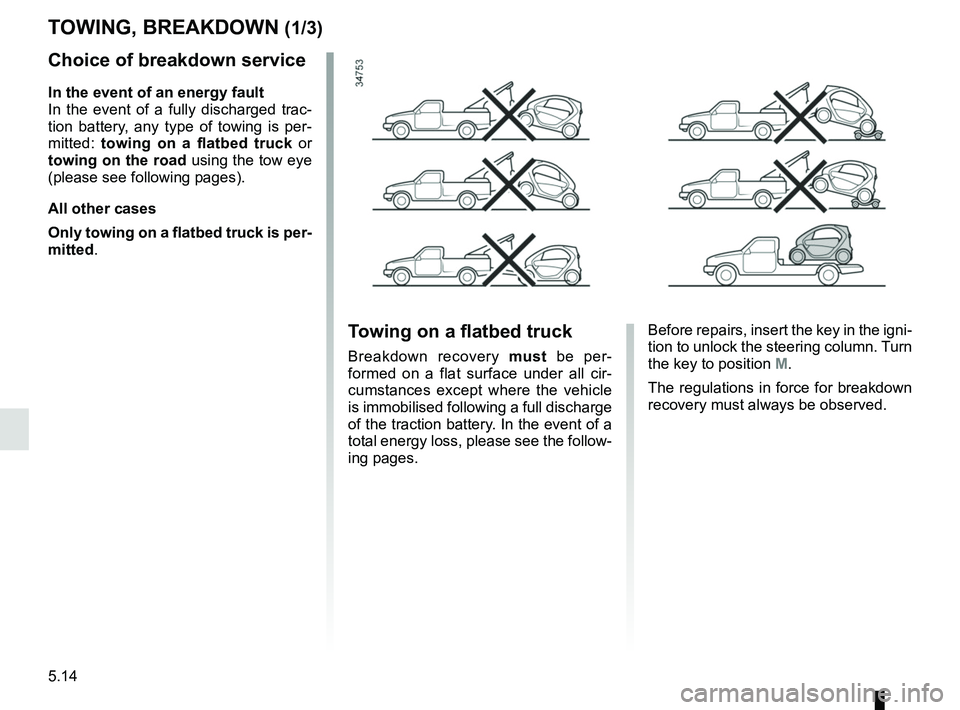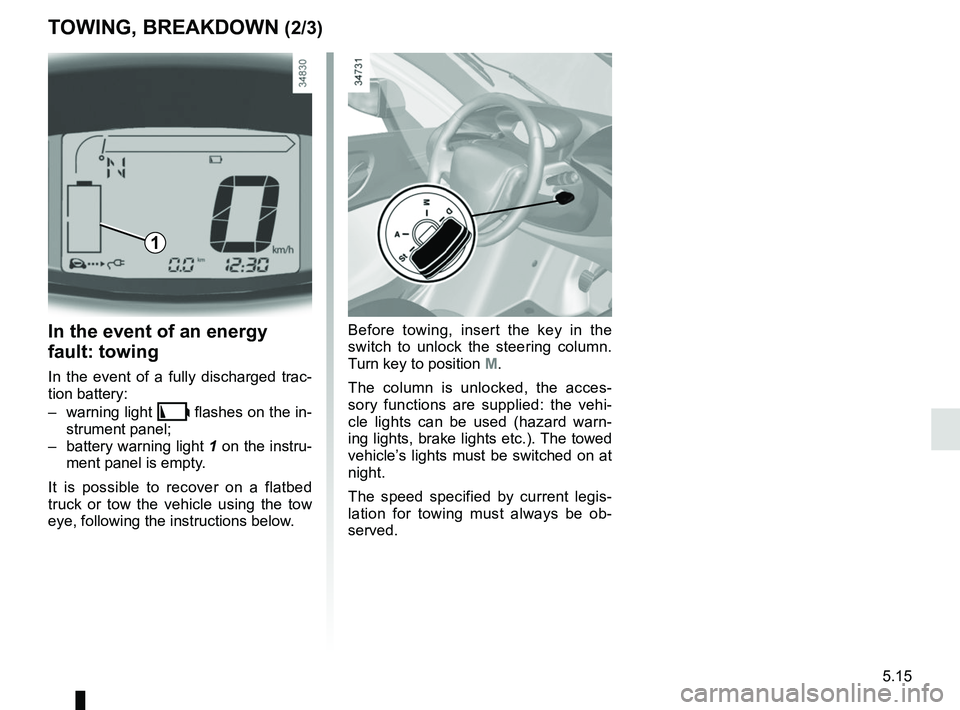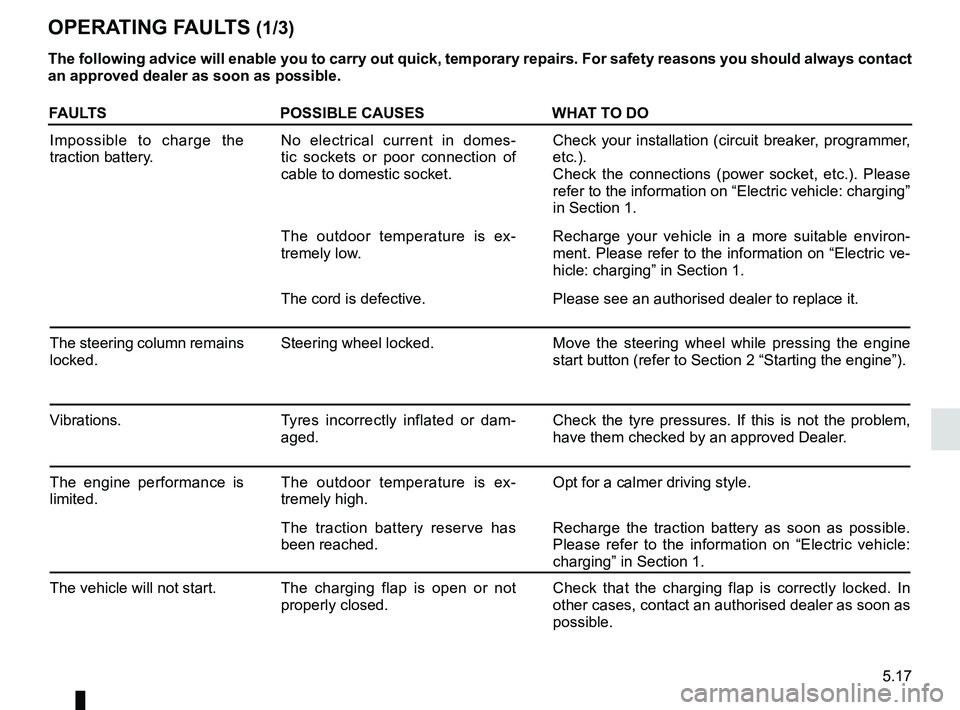steering RENAULT TWIZY 2018 Owners Manual
[x] Cancel search | Manufacturer: RENAULT, Model Year: 2018, Model line: TWIZY, Model: RENAULT TWIZY 2018Pages: 118, PDF Size: 2.51 MB
Page 11 of 118

1.5
ELECTRIC VEHICLE: introduction (4/5)
For safety reasons, adapt
your driving to driving condi-
tions and avoid any sudden
turning of the steering
wheel, especially on steep slopes or
slippery surfaces.
Failure to respect these recommen-
dations may lead to a loss of control
of the vehicle.
Risk of accident and serious injury.
Obstructions to the driver
On the driver’s side, only
use mats suitable for the
vehicle, attached with the
pre-fitted components, and check
the fitting regularly. Do not lay one
mat on top of another.
There is a risk of wedging the
pedals.
Having a passenger effects
vehicle balance, road hold-
ing and increases the vehi-
cle braking distance.
Adapt your driving to the driving
conditions and avoid any sudden
manoeuvre which could lead to a
loss of control over the vehicle. Risk
of accident and serious injury.
Driving
When you lift your foot off the accelera-
tor pedal, the motor generates electri-
cal current during deceleration, and this
energy is used to recharge the traction
battery. Please refer to the information
on the “Charge meter” in Section 2.
An electric motor generates a greater
engine brake than in a petrol or diesel
engine vehicle.
Page 27 of 118

1.21
METHODS OF RESTRAINT IN ADDITION TO THE FRONT SEAT BELTS (2/3)
Side support belt
Please see the information on “Seat
belts” in Section 1.
Load limiter
Above a certain severity of impact, this
mechanism is used to limit the force of
the belt against the body so that it is at
an acceptable level.
Driver’s front airbag
This is fitted in the front seats.
An Airbag marking on the steering
wheel informs you of the presence of
this equipment.
The airbag system consists of:
– an airbag and its gas generator fitted on the steering wheel;
– an electronic unit for system monitor- ing which controls the gas generator
electrical trigger system;
– a single warning light
å on the
instrument panel.
The air bag system uses
pyrotechnic principles. This
explains why, when the air
bag inflates, it will gener-
ate heat, produce smoke (this does
not mean that a fire is about to start)
and make a noise upon detonation.
In a situation where an air bag is
required, it will inflate immediately
and this may cause some minor, su-
perficial grazing to the skin or other
problems.
Page 28 of 118

1.22
METHODS OF RESTRAINT IN ADDITION TO THE FRONT SEAT BELTS (3/3)
Operation
This system is only operational when
the ignition is switched on.
If a severe frontal impact occurs, the
airbag inflates rapidly, cushioning the
impact of the driver’s head and chest
against the steering wheel; the airbag
then deflates immediately after impact
so that the vehicle can be exited with-
out hindrance. All of the warnings below are given
so that the air bag is not obstructed
in any way when it is inflated and
also to prevent the risk of serious in-
juries caused by items which may be
dislodged when the air bag inflates.
Warnings concerning the
driver’s air bag
– Do not modify the steer-
ing wheel or the steering
wheel boss.
– Do not cover the steering wheel boss under any circumstances.
– Do not attach any objects (badge, logo, clock, telephone holder,
etc.) to the steering wheel boss.
– The steering wheel must not be removed (except by qualified per-
sonnel from our Network).
– Do not sit too close to the steering wheel when driving: sit with your
arms slightly bent (see Section 1
“Adjusting your driving position”).
This will allow sufficient space
for the air bag to deploy correctly
and to be fully effective.
Page 44 of 118

1.38
AUDIBLE AND VISUAL SIGNALS
Horn
Press the end of stalk 1.
Headlight flasher
Pull stalk 1 towards you to flash the
headlights.
éHazard warning lights
Press switch 2 . This switch
lights up all four indicators simultane-
ously. It must only be used in an emer-
gency to warn drivers of other vehicles
that you have had to stop in an area
where stopping is prohibited or unex-
pected or that you are obliged to drive
under special conditions.
Direction indicators
Move stalk 1 parallel to the steering
wheel and in the direction you are going
to turn it.
When driving on the motorway, the
steering wheel is not often turned
enough to return the stalk automatically
to 0.
There is also an intermediate position
in which the switch may be held when
changing lanes.
When the stalk is released, it automati-
cally returns to 0.
21
0
Page 50 of 118

2.2
“Accessories” position ANo power-consuming device will oper-
ate when the ignition is switched off.
“On” position MThe ignition is switched on:
Start position D
Starting the engine
Turn the key to the D position and hold
it in this position until you hear a beep.
Release the key.
As soon as warning light
Ṑ stops
flashing, your vehicle is ready to drive.“Stop, steering and
handbrake lock” position St
To unlock: turn the key and the steering
wheel slightly.
To lock: remove the key and turn the
steering wheel until the steering column
locks.
To release the handbrake, please see
the information on “Handbrake” in
Section 2.
STARTING, STOPPING THE ENGINE
The vehicle cannot be started if the
charging cord is plugged in and
powered or if the charging flap is
open.
Stopping the engine
Bring the key to “Stop” position.
Warning light
Ṑ goes out.
Driver’s responsibility
when parking or stopping
the vehicle
Never leave an animal,
child or adult who is not self-suffi-
cient alone on your vehicle, even for
a short time.
They may pose a risk of injury, such
as by starting the engine or activat-
ing equipment.
Risk of serious injury.
Page 88 of 118

5.14
Choice of breakdown service
In the event of an energy fault
In the event of a fully discharged trac-
tion battery, any type of towing is per-
mitted: towing on a flatbed truck or
towing on the road using the tow eye
(please see following pages).
All other cases
Only towing on a flatbed truck is per-
mitted.
TOWING, BREAKDOWN (1/3)
Towing on a flatbed truck
Breakdown recovery must be per-
formed on a flat surface under all cir-
cumstances except where the vehicle
is immobilised following a full discharge
of the traction battery. In the event of a
total energy loss, please see the follow-
ing pages.
Before repairs, insert the key in the igni-
tion to unlock the steering column. Turn
the key to position M.
The regulations in force for breakdown
recovery must always be observed.
Page 89 of 118

5.15
TOWING, BREAKDOWN (2/3)
In the event of an energy
fault: towing
In the event of a fully discharged trac-
tion battery:
– warning light
\b flashes on the in-
strument panel;
– battery warning light 1 on the instru-
ment panel is empty.
It is possible to recover on a flatbed
truck or tow the vehicle using the tow
eye, following the instructions below.
1
Before towing, insert the key in the
switch to unlock the steering column.
Turn key to position M.
The column is unlocked, the acces-
sory functions are supplied: the vehi-
cle lights can be used (hazard warn-
ing lights, brake lights etc.). The towed
vehicle’s lights must be switched on at
night.
The speed specified by current legis-
lation for towing must always be ob-
served.
Page 91 of 118

5.17
OPERATING FAULTS (1/3)
The following advice will enable you to carry out quick, temporary repai\
rs. For safety reasons you should always contact
an approved dealer as soon as possible.
FAULTSPOSSIBLE CAUSES WHAT TO DO
Impossible to charge the
traction battery. No electrical current in domes-
tic sockets or poor connection of
cable to domestic socket. Check your installation (circuit breaker, programmer,
etc.).
Check the connections (power socket, etc.). Please
refer to the information on “Electric vehicle: charging”
in Section 1.
The outdoor temperature is ex-
tremely low. Recharge your vehicle in a more suitable environ-
ment. Please refer to the information on “Electric ve-
hicle: charging” in Section 1.
The cord is defective. Please see an authorised dealer to replace it.
The steering column remains
locked. Steering wheel locked.
Move the steering wheel while pressing the engine
start button (refer to Section 2 “Starting the engine”).
Vibrations. Tyres incorrectly inflated or dam-
aged. Check the tyre pressures. If this is not the problem,
have them checked by an approved Dealer.
The engine performance is
limited. The outdoor temperature is ex-
tremely high. Opt for a calmer driving style.
The traction battery reserve has
been reached. Recharge the traction battery as soon as possible.
Please refer to the information on “Electric vehicle:
charging” in Section 1.
The vehicle will not start. The charging flap is open or not
properly closed. Check that the charging flap is correctly locked. In
other cases, contact an authorised dealer as soon as
possible.